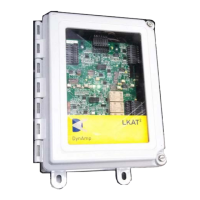Installation, Operation and Service Manual LKAT
2
+24V
© 2018 DynAmp, LLC Page 14
046404 E
4.3 OFF-BUS FUNCTIONAL CHECK (OPTIONAL)
After unpacking the LKAT
2
System (but prior to installation), the following functional check of
the system is recommended:
1. Locate a convenient temporary power source for the LKAT
2
System. This may or may not
be in the location where the system will be installed. The power source must be in the
range 18-36Vdc. The system draws a maximum of 30 volt-amperes.
2. Refer to the drawing “Wiring Diagram, LKAT
2
System” included at the end of this manual.
Attach a suitable connector to the unterminated end of the input power cable assembly for
connection to the power source to be used for this check.
3. Connect the Measuring Head cables A & B to the Metering Unit.
4. Connect the power input cable assembly to the Metering Unit and energize the unit.
5. Observe the LEDs on the Main pc board assembly. If the LEDs light green, the system is
functioning properly. If LED (Accuracy Diagnostics “AD”) lights red, skip to
“Troubleshooting an Accuracy Diagnostics Fault Indication” in the “Theory of Operation”
section of this manual. If LED (Trip 1) lights red, make measurements and complete the
form “LKAT
2
Diagnostic Measurements Form – Zero Primary Current” and contact the
factory.
Refer to Form 1 – Zero Primary Current. Allow the system one hour to stabilize prior to
making measurements. Make measurements and record data shown on the form. File the
completed test form for future reference. It is OK to make these measurements away from
location where the LKAT
2
System will be installed, but this should be noted on the form.
4.4 MEASURING HEAD INSTALLATION
The head halves are mated together around the bus. The Measuring Head is comprised of
two “L” shaped halves. Each half is identified with a serial number which must match followed
by an “A” or “B”. One interconnection cable exits from each corner box on each half. The two
halves are held together by four locking screws which are installed after the head is securely
positioned around the bus bar.
When the Measuring Head is installed on a running (“horizontal”) bus, the head
interconnection cable assemblies should exit the corner enclosures on bottom side of the bus
bar. This reduces chances of ingress by pollutants and minimizes heating of the head
electronics by the bus.
For rising (“vertical”) busses, the head interconnection cables may be located on any side of
the bus, depending on mechanical and thermal considerations. Avoid mounting boxes above
vertical bus. The head should be mounted on the bus bar so conventional (+) to (-) current
flows in the direction of the arrow on the Measuring Head.
The following tools and materials may be required for installation:
3/16” hex wrench (included with Measuring Head)
Drill, drill bits, mounting hardware, screwdrivers, wrenches, etc.
Cable puller, cable ties, ladder, etc.

